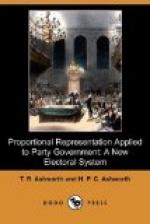+Sir John Lubbock.+[1]—We have asserted that the proportional principle should be applied to two parties only—the majority and the minority, and that every section can then be represented. Mill and Hare thought that no limit should be set except the size of the assembly. All the recent advocates of the system take up an intermediate position. Appreciating the serious objections against allowing independent representation to a large number of small sections, Sir John Lubbock, president of the English Proportional Representation Society, proposes to constitute electorates returning only three to five members each, thus confining representation to only three to five sections in each electorate, and sacrificing to a great extent accurate proportional representation. In his book on “Representation,” he writes:—“I have assumed that Parliament should be ‘a mirror of the nation;’ if the object were to secure unity of action rather than freedom of discussion, to form an executive body such as a Government, a Board of Directors, or a Vestry, the case would be quite different. It is, however, I presume, our wish that Parliament should be a deliberative assembly in which all parties should be fairly represented.” But to make Parliament a deliberative body is to destroy its power to secure unity of action at all, and to render it useless as a working machine.
+Miss Spence.+—An active campaign has for some time been carried on for the adoption of the Hare system in Australia. Miss C.H. Spence, of South Australia, was the pioneer reformer, and has laboured in the cause by pen and voice for no less than forty years. Great credit is undoubtedly due to Miss Spence for the clear and simple manner in which she has expounded the system, and for the good work she has done in exposing the defects of the present methods. Not only has she lectured in all parts of Australia, but she has made visits to England, where she met Mr. Hare and Sir John Lubbock, and also to America. But we may admire Miss Spence’s courage and devotion to principle without agreeing with her conclusions.




